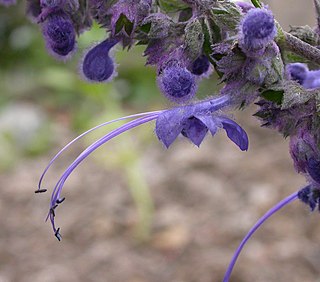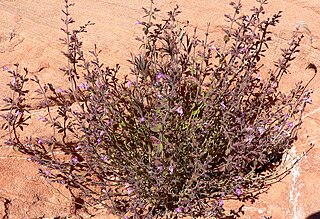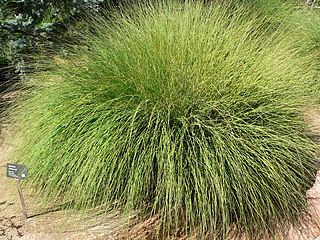
Nolina is a genus of tropical xerophytic flowering plants, with the principal distribution being in Mexico and extending into the southern United States. They are large, dioecious plants.

Encelia is a genus of the plant family Asteraceae. It consists of shrubs of arid environments in southwestern North America and western South America.

Bouteloua is a genus of plants in the grass family. Members of the genus are commonly known as grama grass.

Garrya is a genus of flowering plants in the family Garryaceae native to Mexico, the western United States, Central America and the Greater Antilles. Common names include silk tassel and tassel bush.

Aridoamerica denotes a cultural and ecological region spanning Northern Mexico and the Southwestern United States, defined by the presence of the drought-resistant, culturally significant staple food, the tepary bean. Its dry, arid climate and geography stand in contrast to the verdant Mesoamerica of present-day central Mexico into Central America to the south and east, and the higher, milder "island" of Oasisamerica to the north. Aridoamerica overlaps with both.

Hymenoxys is a genus of plants in the sunflower family, native to North and South America. It was named by Alexandre Henri Gabriel de Cassini in 1828.

Stephanomeria is a genus of North American plants also known as wirelettuce, belonging to the tribe Cichorieae within the family Asteraceae.

Heterotheca is a genus of North American plants in the family Asteraceae.

Trichostema is a genus of flowering plants in the family Lamiaceae, which are aromatic herbs or subshrubs. These plants are native to North America. Many plant of this genus which have whorls of small blue flowers are called by the common name bluecurls.

Isocoma, commonly called jimmyweed or goldenweed, is a genus of North American semi-woody shrubs in the family Asteraceae. It is found in the semi-arid areas of Southwestern United States and Mexico.

Houstonia (bluet) is a genus of plants in the family Rubiaceae. Many species were formerly classified, along with other genera since segregated elsewhere, in a more inclusive genus Hedyotis.

Thymophylla is a genus of perennial flowering plants in the tribe Tageteae within the family Asteraceae. Pricklyleaf is a common name for plants in this genus.

Hedeoma is a genus of flowering plants in the mint family, Lamiaceae. It is native to North and South America. They are commonly known as false pennyroyals.

Muhlenbergia is a genus of plants in the grass family.

Machaeranthera is a genus of North American flowering plants in the family Asteraceae which are known by the common name tansyaster.

Hilaria is a genus of North American plants in the grass family. Members of the genus are commonly known as curly mesquite. They are found in the Southwestern United States, Mexico, and Guatemala.

Pilostyles thurberi is a species of endoparasitic flowering plant known by the common names Thurber's stemsucker and Thurber's pilostyles. It is native to the southwestern United States and northern Mexico, where it grows in desert and woodland. In the United States, P. thurberi has been recorded from the states of Arizona, California, New Mexico, Nevada, Texas.

Hymenothrix wrightii, commonly known as Wright's hymenothrix or Wright's thimblehead, is a North American species of flowering plant in the daisy family. It grows in northwestern Mexico and the southwestern United States.

Hymenothrix wislizeni, the Trans-Pecos thimblehead, is a North American species of flowering plant in the daisy family. It grows in northwestern Mexico and the southwestern United States.



















